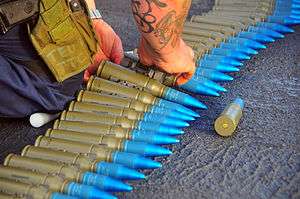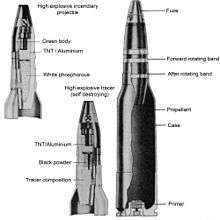25 mm caliber
The 25 mm caliber is a specific size of cannon or autocannon ammunition. It has also been recently used for the Barrett XM109 anti-material rifle. Such ammunition includes the NATO-standard 25×137mm and 25×184mm rounds, Soviet 25x218mmSR, as well as the World War II-era French-designed 25×163mm and 25×193.5mmR rounds.

Usage
The 25 mm round can be used in both an anti-materiel and anti-personnel fashion. When operating in the anti-personnel role, a 25 mm weapon armed with HE rounds can effectively kill large numbers of opposing troops either in the open or in light fortifications. When operating in the anti-materiel role, a 25 mm weapon armed with armor-piercing rounds can disable many aircraft and vehicles, including some main battle tanks.
The US military uses 25 mm weapons in their AV-8B Harrier, AC-130 gunship, M2 Bradley, LAV-25, F-35 Lightning II and as a standard ship-based munition in the Mk 38 autocannon.
Types of 25 mm ammunition


Several sub-types of the NATO 25 mm ammunition are available—the most common being armor-piercing, high-explosive, sabot, tracer, and practice rounds. Cartridges are usually composed of a combination of the aforementioned categories. For example, the M791 pictured to the right is an armor-piercing discarding sabot with tracer (APDS-T) round. It is used against lightly armored vehicles, self-propelled artillery, and aerial targets such as helicopters and slow-moving fixed-wing aircraft.
25 mm weapons
Each weapon is listed with its cartridge type appended.
Current weapons
- M242 Bushmaster: 25×137mm
- GAU-12/22 Equalizer: 25×137mm
- GIATs, 25M811: 25×137mm
- Oerlikon KBA: 25×137mm
- Oerlikon KBB: 25×184mm
- Oerlikon KBD: 25×184mm
- Type 61 25×218mmSR
- Type 95 SPAAA:25×183mmB
- ZPT90:25×183mmB
Historical weapons
- 25 mm Hotchkiss anti-aircraft gun/Type 96 25 mm AT/AA Gun: 25×163mm
- 25 mm Hotchkiss anti-tank gun: 25×193.5mmR
- 25 mm M1940 anti-aircraft gun: 25×218mmSR
- 25 mm Bofors M/32 anti-aircraft gun: 25x205mmR (initial) or 25x187mmR (later)
See also
- Caliber
- .50 BMG
- 14.5×114mm
- 20 mm caliber
- 23 mm caliber
- 25 mm caliber
- 30 mm caliber
- List of cartridges (weaponry), pistol and rifle
Further reading
- U.S. Army Field Manual 3-22.1